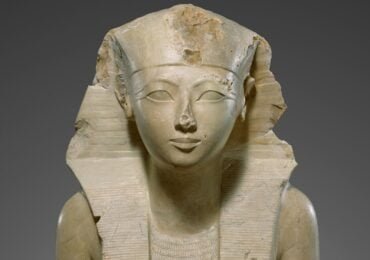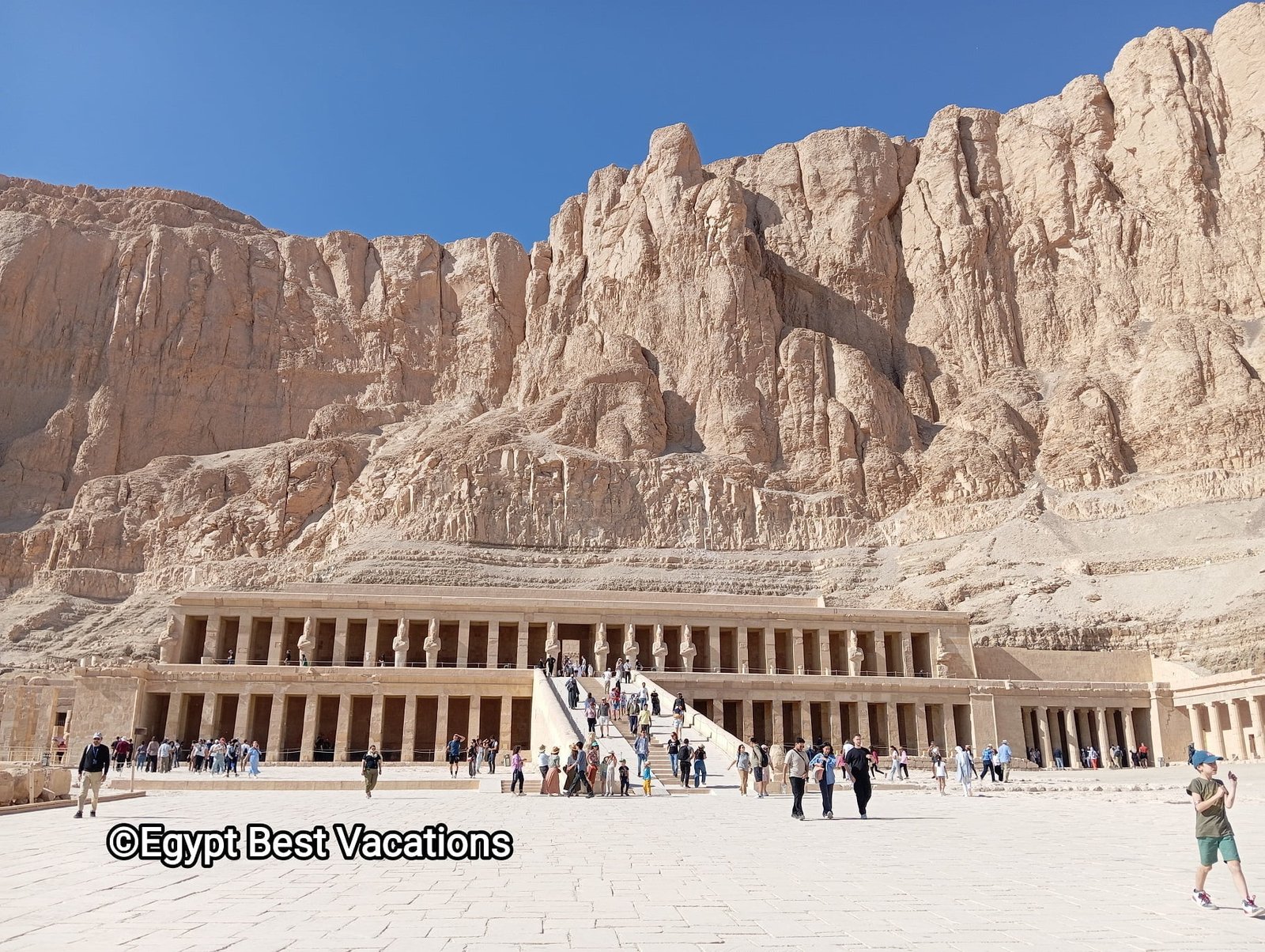Temple of Hatshepsut at Deir El-Bahari in Luxor
Step into the realm of the Temple of Hatshepsut, where the echoes of ancient Egypt’s grandeur and architectural mastery resonate. Situated against the cliffs of Deir el-Bahari, this imposing monument reveals the captivating tale of one of Egypt’s extraordinary female pharaohs. Embark with us on a voyage through time, delving into the rich history and intricate craftsmanship that define the mortuary Temple of Hatshepsut. Hatshepsut Temple is one of the must-see attractions in Luxor.
Hatshepsut Temple opening Hours:
- Daily : 6:00 AM to 5:00 PM, tickets over by 4:30 PM
- Entrance fee: 360 EGP per adult +12 years
- 180 EGP per child (6 – 11.99 years) or students with student card
Who is Hatshepsut?
At the time of Tuthmosis I’s death, the scene at the royal court was quite complicated. For a man born into the royal family, the legitimate rule usually came from his mother if she was a queen. Though otherwise, he might derive his authority through the marriage to another royal woman, including his sister, his half-sister, aunt, niece, or even his own daughter. Tuthmosis I was a non-royal general who became king by marrying the previous pharaoh’s sister Ahmose.
Since Tuthmosis I’s two oldest royal sons had died. The legitimate heir to the throne was the third son, Tuthmosis II (from a non-royal wife), who was made to marry his half-sister Hatshepsut. The couple ruled jointly for a few years. Tuthmosis II died prematurely, leaving as heir an illegitimate son by a non-royal wife, named Tuthmosis III, and tagged as a legitimate heir by his father. The future of Tuthmosis III was still a child when Hatshepsut stepped into the post of regent.
Hatshepsut was an intelligent woman of uncommon ability, with a keen political sense. Perhaps when she aged 15 was named co-regent by her father toward the end of his life. She was also attractive and ambitious. She wanted to be a king, not a mere queen, and thus desired divine legitimation.

Hatshepsut as divine daughter of Amun:
Accordingly, with the help of the priests of Amun, she claimed divine origin from the god Amun. Therefore, she was the “daughter of the king. Sister of the kings, wife of the god” and the “Great Royal Wife”. At this point, Hatshepsut began to assume masculine characteristics. She adopted royal protocol, wore men’s clothing and an artificial beard, and suppressed the feminine endings of her names.
Plan your tour: Luxor full-day tour to west and east banks
Pharaoh Hatshepsut (1479-1458 BCE) is the first recorded female ruler in history. The first recorded female patron of large-scale art and architectural projects. She also began dedicating her time to architecture and to promoting new trade policy, which culminated in the expedition to the Land of Punt. She died at the age of (45-52 years) from diabetes and was buried at the Valley of the Kings in Luxor.
Senmut, Achitect of Temple of Hatshepsut:
1200 years after Imhotep, who built the Step Pyramid of Saqqara. Another architect, Senmut, appeared on the scene of Egyptian history with another architectural masterpiece. “Senmut” means “mother’s brother” or could be translated as “brother of Goddess Mut”. He was the Chief Steward of Amun, a private tutor to Princess Neferure (Hatshepsut’s daughter). He was the son of Ramose (father) and Hutnefer (mother). Who were probably from Iuny (modern Armant, south of Luxor).

The star of Senmut ascended when Hatshepsut became regent for Tuthmosis III. He was put in charge of the quarrying of her two obelisks at Aswan granite quarry. One of these obelisks still stands at Karnak Temple. Then he was promoted to the position of Chief Steward of Amun. Senmut is often credited as the Chief Architect of the Mortuary Temple of Hatshepsut at Deir El-Bahari. A unique privilege was given to his to construct his own tomb beneath the temple of his queen. Although his tomb is about 15 meters from the east corner of the 1st terrace. He was not buried here but at Sheikh Abdel-Qurnah.
Mortuary Temple of Hatshepsut at Deir El-Bahari:
Through building projects, Hatshepsut assured divine favor and prosperity for her and her people. She proved that she was a responsible ruler securing the best for Egypt. Queen Hatshepsut, more a patron of the arts than a military leader. She ordered a funerary monument for her father Tuthmosis I, and for herself. Hatshepsut chose an impervious valley already consecrated to the goddess Hathor who, in the form of a heifer, received the deceased in the underworld. The temple of Hatshepsut was in later times abandoned, at a certain point in history. It became a Christian convent called the Convent of the North. This fact not only gave the area its present name of Deir El-Bahari but also preserved the pharaonic temple from further destruction.

Hatshepsut’s temple is positioned next to the temple of Montuhotep II to reinforce her position among the kings. The mortuary Temple of Hatshepsut is one of many archaeological UNESCO World Heritage sites. The temple of Hatshepsut was called in antiquity Djesr-Djesru (Holy of the Holies) and is unique in Egyptian architecture. It consisted of a series of vast terraces which, via ramps, led up to the sanctuary. An avenue of sphinxes led to the first terrace, from which another ramp led to the second and the third terraces. This temple was for the continued rituals that honored her as a deity and assured her favored association with other powerful and personal gods.
Expedition to Punt:
The expedition to Punt orchestrated by Hatshepsut holds immense historical significance in ancient Egypt. Queen Hatshepsut’s famous expedition to Punt (Sudanese or Somali coast) is recorded in the left colonnade of the second terrace. This trading mission was the first time an Egyptian force had been so far for 5000 years. It was a huge success and, as the carvings show, the fleet returned laden with ivory, baboons, leopard skins, and, most precious of all, incense. An essential ingredient of temple rituals and said to embody the spirit of the deities.
Plan your tour: Tour to Kings Valley, Hatshepsut and Colossi of Memnon
Chapel of Hathor:
The Hathor Chapel within the Temple of Hatshepsut is a striking manifestation of both ancient Egyptian religious fervor and architectural finesse. Hathor was the goddess of love, music, and joy. The chapel of Hathor is located to the left side of the Punt colonnade. The chapel is formed of two chambers with Hathor-headed columns. On the west wall, Hathor is depicted as a cow licking Hatshepsut’s hand. The left wall dipects Hatshepsut drinking from Hathor’s udder. While on the right wall, she celebrates the Heb-Sed (a festival is celebrated every 30 years by the pharaoh) festival with her soldiers.
Divine Birth Colonnade:
Reliefs on the right colonnade of the second terrace depict the legend of her “Divine Birth” by god Amun-Re. Amun-Re took on her father’s appearance and made love to her mother. This claim was made by the queen to help justify her position to the people. She claimed, as one inscription records that her father had appointed her as his successor.
After her death, her stepson and successor Tuthmosis III, did his best to erase her images. Some say it was an act of vengeance. Others believe it was to ensure a smooth succession of his own son to the throne. A third theory proposes that he didn’t want the rule of kings Tuthmosis I, II, and III interrupted by a woman.
Plan your trip: Luxor west bank with balloon and felucca rides
Chapel of Anubis:
The chapel of Anubis is situated to the right of the Divine Birth Colonnade. Anubis is the guardian and guide to the dead. God Anubis also was the god of death and mummification who helped Isis embalming her husband’s body.
On the right wall of the chapel, Hatshepsut’s father (Tuthmosis I) is depicted before the falcon-headed god, Horus. Hatshepsut is offering a big heap of offerings to Amun-Re and to Anubis on the rare wall. All of Hatshepsut’s images and names on the chapel’s walls are erased but one on the left wall depicts Hatshepsut as a woman (not pharaoh) before the god Anubis.
Third Terrace of the Temple of Hatshepsut:
The gate to the third terrace is fronted by a line of Hatshepsut’s statues as Osiris (mummy form). This terrace is restored by the Polish-Egyptian Expedition over the last 25 years. The terrace is surrounded on three sides by sanctuaries. A door in the middle of the rare wall leads to the sanctuary of Amun-Re, which is hewn out of the cliff. This sanctuary was refurbished and rededicated to the deified individuals of Imhotep and Amenhotep Son of Habu, during the Ptolemaic Period. The Sanctuary is open the public right now.
How to get to Hatshepsut Temple from Luxor?
To get to Hatshepsut Temple from Luxor, you have a few transportation options:
- Taxi or Private Car: You can hire a taxi or arrange for a private car to take you directly from Luxor to Hatshepsut Temple. This option provides flexibility in terms of timing and allows you to travel at your own pace. Make sure to negotiate the fare with the driver before starting your journey.
- Ferry: You can also take a ferry across the Nile River from Luxor to the West Bank. Once on the West Bank, you can either walk or take a taxi to Hatshepsut Temple. Ferries usually depart regularly throughout the day and offer a scenic way to travel between the two banks of the Nile.
- Guided Tours: Egypt Best Vacations offers a wide range of Luxor day tours that some of them include Hatshepsut Temple.
Regardless of which option you choose, make sure to check the operating hours of Hatshepsut Temple and plan your visit accordingly. It’s also a good idea to wear comfortable clothing and shoes, as you may need to do some walking or climbing at the temple site.
The Temple of Hatshepsut is included in all of our Egypt trips. Book your Egypt tour Now!

